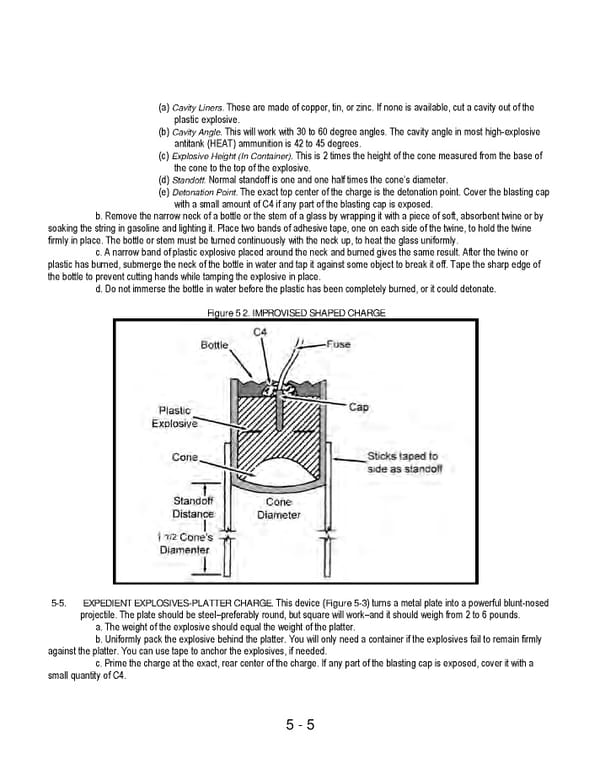5 - 5 (a) Cavity Liners. These are made of copper, tin, or zinc. If none is available, cut a cavity out of the plastic explosive. (b) Cavity Angle. This will work with 30 to 60 degree angles. The cavity angle in most high-explosive antitank (HEAT) ammunition is 42 to 45 degrees. (c) Explosive Height (In Container). This is 2 times the height of the cone measured from the base of the cone to the top of the explosive. (d) Standoff. Normal standoff is one and one half times the cone’s diameter. (e) Detonation Point. The exact top center of the charge is the detonation point. Cover the blasting cap with a small amount of C4 if any part of the blasting cap is exposed. b. Remove the narrow neck of a bottle or the stem of a glass by wrapping it with a piece of soft, absorbent twine or by soaking the string in gasoline and lighting it. Place two bands of adhesive tape, one on each side of the twine, to hold the twine firmly in place. The bottle or stem must be turned continuously with the neck up, to heat the glass uniformly. c. A narrow band of plastic explosive placed around the neck and burned gives the same result. After the twine or plastic has burned, submerge the neck of the bottle in water and tap it against some object to break it off. Tape the sharp edge of the bottle to prevent cutting hands while tamping the explosive in place. d. Do not immerse the bottle in water before the plastic has been completely burned, or it could detonate. Figure 5 2. IMPROVISED SHAPED CHARGE 5-5. EXPEDIENT EXPLOSIVES-PLATTER CHARGE. This device (Figure 5-3) turns a metal plate into a powerful blunt-nosed projectile. The plate should be steel–preferably round, but square will work–and it should weigh from 2 to 6 pounds. a. The weight of the explosive should equal the weight of the platter. b. Uniformly pack the explosive behind the platter. You will only need a container if the explosives fail to remain firmly against the platter. You can use tape to anchor the explosives, if needed. c. Prime the charge at the exact, rear center of the charge. If any part of the blasting cap is exposed, cover it with a small quantity of C4.
 Ranger Handbook Page 88 Page 90
Ranger Handbook Page 88 Page 90